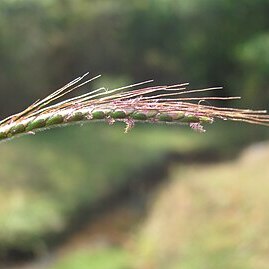Perennial; culms 20–100 cm. high, geniculately ascending.. Leaf-blades 3–25 cm. long, 2–5 mm. wide.. Inflorescence composed of 1–6 subdigitate shortly pedunculate racemes, the peduncles and the culm below the inflorescence pubescent; racemes 2–8 cm. long, the spikelets imbricate, with 1–6 smaller homogamous pairs at the base.. Sessile spikelet elliptic to obovate, 2–5 mm. long; lower glume firmly chartaceous, broadly convex, pilose below the middle, glabrous above or shortly ciliate along the margins and near the apex, broadly obtuse or with a subacute membranous tip; awn 10–20 mm. long.
Sessile spikelets 2–5 mm long, obovate; inferior glume slightly concave, pilose below the middle, glabrous or shortly pilose above the middle towards the margins and apex, narrowly winged towards the apex; superior glume as long as the inferior, glabrous except for the often shortly ciliate keel and margins; inferior floret barren, the lemma hyaline; superior floret stipitiform, the lemma hyaline; awn c. 22 mm long, minutely pubescent on both column and bristle; anthers c. 2 mm long.
Tufted perennial 1100 mm high; short stolons present; culm velvety hairy below inflorescence; nodes glabrous or short-woolly hairy. Leaf blade 30-250 x 2-7 mm. Inflorescence with 1-3 racemes, rarely 4 or 5; spikelets closely overlapping. Sessile spikelet 3.0-4.5 x 2.5 mm, obovate; lower glume 2.5 mm wide, glabrous or shortly hairy above middle towards margins and apex, lateral keels narrowly winged; lemma awned; awn ± 22 mm long, hairy; anther 1.5-2.0 mm long.
Caespitose perennial with short stolons; culms up to 110 cm high, robust, erect or sometimes decumbent; nodes exposed and glabrous; internodes glabrous; leaf sheaths glabrous; ligule a scarious membrane; leaf laminas up to 25 cm × 2–5 mm, linear-lanceolate, glabrous for most of their length but long-pilose near the ligule.
Racemes 1–5, subdigitate, shortly pedunculate, the peduncles and the culm below the inflorescence pubescent; rhachis internodes and pedicels usually pilose on one side, glabrous on the other; the lowermost 1–6 spikelet pairs usually homogamous, male or neuter.
Perennial; up to 1.1 m high; tufted. Culms velvety below inflorescence; nodes glabrous or short-woolly. Leave blades 30-250 x 2-7 mm. Flowers: inflorescence digitate; sessile spikelets 3.0-4.5 x 2.5 mm; lower glume of sessile spikelets up to 2.5 mm wide.
Perennial, tufted, up to 1.1 m high. Nodes glabrous or short-wooly. Culms velvety below inflorescence. Leaf blades 30-250 mm long, 2-7 mm wide. Spikelets (sessile) 3.0-4.5 mm long, 2.5 mm wide; lower glume of sessile spikelets to 2.5 mm wide.
Pedicelled spikelets similar to the sessile spikelets in size and shape, male or neuter.

